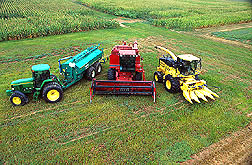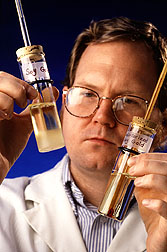This page has been archived and is being provided for reference purposes only. The page is no longer being updated, and therefore, links on the page may be invalid.
|
More stories
More information:
ARS researcher in Peoria, Ill., inspects chilled fuels winterized for better engine start-ups in cold weather. |
ARS Center to Heat With Soy-Based Biodiesel This WinterBy Don ComisOctober 31, 2000 WASHINGTON, Oct. 31--As the country faces a winter with tight supplies of home heating oil, some U.S. Department of Agriculture employees in Beltsville, Md., as well as nearby dairy cows, will stay warm this winter with biodiesel fuel, Agricultural Research Service Administrator Floyd Horn announced today. Building on success with a fuel made from soybean oil for ARS snowplows, tractors and other vehicles, Horn said ARS has begun heating a dozen buildings on its 7,000-acre Henry A. Wallace Beltsville Agricultural Research Center (BARC)--including two dairy barns--with a “B5" biodiesel blend: 5-percent soy-based biodiesel and 95-percent heating oil. ARS is USDA’s chief scientific research agency. “For more than a year, BARC’s fleet of 150 farm and road vehicles has been using 'B20,' a 20-percent soy-based biodiesel/80-percent regular diesel mix. These vehicles include trucks and the center’s tour bus,” Horn said. “Since we began using biodiesel in August 1999, 40 large vehicle fleets across the country have done likewise. Now, we are taking the lead in introducing the country to heating with biodiesel, as Europeans already do.” “This would help reduce the potential home heating oil crisis facing the Northeast this winter and reduce our nation’s dependence on foreign oil,” Horn said. “If everyone in the Northeast used just the B-5 blend, it could save 50 million gallons of regular heating oil this winter.” John Van de Vaarst, ARS deputy area director for the Beltsville Area, said that biodiesel is working at least as well as regular diesel fuel in the vehicles. “Plus, it is cleaner-burning and is better for the environment,” Van de Vaarst said. “It also may be keeping the vehicles’ engines cleaner, lowering maintenance costs.” “We chose a B5 blend for heating to reduce potential clogging of the boilers' fuel filters and strainers with sludge which has settled in the storage tank over the years. Biodiesel has excellent solvent properties that clean the tank and accessories. But, a higher blend could cause clogging,” Van de Vaarst said. Higher concentrations--up to 100 percent biodiesel--can be used for both residential and industrial heating, although B5 to B20 blends are more likely to be used widely, at least initially. Van de Vaarst said that biodiesel costs more than regular diesel, but the difference in price has narrowed considerably in the past year, as diesel oil prices have risen. “Today, B20 costs about 25 cents a gallon more than regular diesel and B5 costs about a nickel a gallon more, “ Van de Vaarst said. “But that gap could be narrowed more as winter arrives,” Van de Vaarst said. “It is easy to switch to biodiesel heating fuel because no modifications are needed to existing heating equipment.” Horn said that ARS decided to lead the way in using biodiesel to run vehicles and heat buildings because it has many payoffs for the country. “Farmers sell more soybeans or other oilseed crops, hopefully at a higher price; we conserve petroleum; and we get cleaner air. The U.S. Department of Energy’s National Renewable Energy Laboratory estimates the cancer-causing potential of biodiesel exhaust is 94 percent less than that of petroleum diesel.” Contact: John Van de Vaarst, Facilities Management and Operations Division, Henry A. Wallace Beltsville Agricultural Research Center, Beltsville, Md., phone (301) 504-5664, vandevj@ba.ars.usda.gov. |


